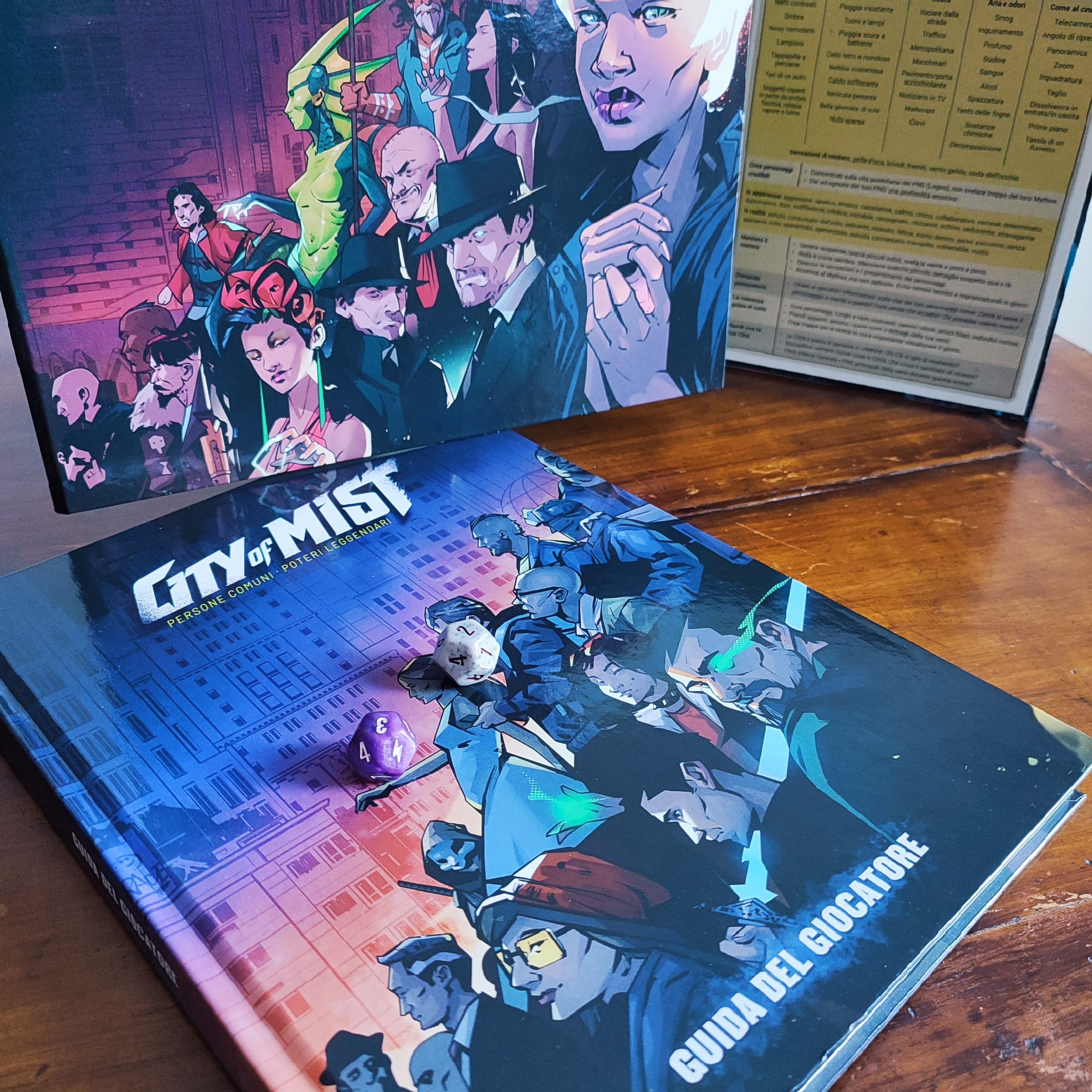Before starting this review of the new edition of City of Mist, I would like to thank Isola Illyon who provided us with a copy of this wonderful product and its exclusive accessories that you can find in their store. The Player’s Guide has a price absolutely in line with the market, it is in fact available at a price of 40 euros while the Master Ceremony screen costs 25 euros.
The game was written by Amit Moshe, edited by Son of Oak Games, and distributed by Modiphius on the overseas market and by Isola Illyon Edizioni in Italy. You can find it on the CIty of Mist store.
City of Mist is a game based on the PbtA system (Powered by the Apocalypse). This game system, created by Vincent Baker in 2010, gives more importance to the interaction and storytelling of the players by relegating the dice rolls to a secondary role. This allows the game to fully exploit the noir and mystical setting, the strong point of this product. So this game system leaves a lot of room for the undoubtedly most charming aspect of this title: the setting.

Sources and Inspirations
CIty of Myst takes something from both noir genres and graphic novels like Sin City and floods them with color. In fact, within the Player’s Guide each section is visually presented with several illustrations that tell the story of Detective Farrah Enkidu, the character who accompanies the reader in understanding the setting of this admirable work.
City of Mist doesn’t stop there, however, as we’ll find out in this review. In fact, we are talking about a game that is difficult to ascribe to a particular genre; even the term noir in fact does not quite fit this RPG that takes inspiration from urban fantasy, investigative and superheroes.
The specific mood is entirely defined by the Master of Ceremonies, the term used to refer to the master, and to the game group that can modulate it according to their preferences.
City of Mist Setting
As we will see in this review, the setting of City of Mist starts from the assumption that the protagonists are ordinary people who carry the spirit of a Legend called Mythos within themselves. The “Mist” of the title, however, envelops everything and keeps people in a state of sleep compared to the reality in which they live. It is not an atmospheric phenomenon, but a real metaphysical veil that hides the true and extraordinary phenomena from the eyes of the Sleepers.

The Mist, therefore, alters perception and transforms weird phenomena into rational explanations; above all, it pushes people to forget any event out of the ordinary that they have witnessed. When a traumatic event breaks through the Mist, a person can, for a single moment, see reality as it is or, as in the case of the PCs, Awaken.
The veil of the Mist, therefore, hides things behind a familiar aspect and makes everyone forget what wonders and horrors lie beyond the appearance of the usual City. The only ones who can see beyond the Mist are the Rifts, people touched during their lifetime by a mystical force, which awakens the Mythos. It does not matter if this entity is Odin or Don Quixote, the spirit of Excalibur, or that of the Philosopher’s Stone.
All the other inhabitants of the city, unaware of what lies beyond the Mist, are called Sleepers; those who discover supernatural powers within themselves upon awakening are referred to as the Rifts. These extraordinary gifts, these exceptional powers are granted to the characters by entities, or Mythos, ideas or characters and objects that are legendary or so popular that they have become part of the common culture.
Themes, Attributes, and Conflicts
The characters, therefore, are in constant conflict; their common life, called Logos, could not get along with the mythical and supernatural powers. This relationship between the “common” themes, such as the character’s profession or his family, and the Mythos, which is everything that directly concerns the Legend that the character hosts, represents the center of the narrative and dynamics of the game.
If the characters neglect their Mythos for too long, devoting themselves to their daily life, this will gradually lose its power until the character returns to be a Sleeper. On the other hand, if they let themselves be carried too much by the mythical component, neglecting their Logos, they will detach themselves more and more from being human to become the Avatar of the Mythos that they represent.

The Player’s Guide
In this new edition, the City of Mist Player’s Guide looks amazing: 304 full-color pages and solid hardcover. Embellished with notable illustrations, it reveals particular attention to readers thanks to boxes, side paragraphs, and text excerpts highlighted in different colors. These subdivisions, with specific functions, serve to capture the attention and facilitate reading all the paragraphs.

The volume is written and structured in such a way that the consultation is really simple. All the parts dedicated to the rules are summarized in the yellow-colored pages. Player’s Guide is divided into four parts: the first dedicated to the City and the Mist; the second reserved for character and group creation; the third to the rules of the game and the fourth for character growth.
If we really wanted to make a note, a bookmark would have been appreciated so that we could keep the mark when looking for references or notes.
The PbtA Game System
City of Mist uses the well-known Powered by the Apocalypse game system, extremely linked to the narration and the description of the actions performed by the characters. The shared narrative, therefore, becomes fundamental while the roll of the dice is limited to the minimum necessary. For those unfamiliar with this system, note that it uses themes rather than races or classes, for example.
When the player needs to make a check, he rolls two six-sided dice. The Power that the character intends to use must be added to the result of the die; the character’s Weakness instead has to be subtracted. If the final result is between 7 and 9, a partial success will be obtained; if the result is 10 or more, the success will be complete; any value obtained below 7 is instead a failure. To complete the mechanics of the tests, the Core Moves chosen by the players and the Statuses eventually assigned by the Master of Ceremony must be considered.
Character Creation

The creation of the characters, which requires a dedicated session 0, takes place through the choice of 16 attributes and 4 questions or affirmations. In City of Mist, as we will see in this review, there isn’t a classical character sheet; in its place, there is a series of cards to be filled in, both on the front and on the back; one for the character and one for each of the 4 themes.
First of all, the Mythos and the Logos of the character must be chosen: the first determine what is the concept that lies within the character and what powers obtain; the second describes instead the job that the character does in his everyday life. By answering a series of questions, four themes must then be identified, two related to Mythos and two related to the Logos. These Themes describe the legendary powers or everyday life of a Rift. Each theme has a dedicated card to be filled in; for each of them, it is necessary to indicate a weakness or limitation and a strong point, a Mystery, or an Identity that motivates the character to act.
However, the character in City of Mist is not a crystallized and immutable entity. In fact, during the game, a Rift could lose a Logos Theme and replace it with a Mythos. This happens when she feels a greater commitment to her mythical side. On the contrary, it may also happen that she loses a Mythos Theme to replace it with a new Logos theme. This possibility indicates a momentary greater attachment to one’s daily life.

Team Creation in City of Mist
The creation of the Team is one of the fundamental components of the story in City of Mist. This is a stage to be completed when all the characters have been completed and the Theme Cards have been filled in. The Team Theme represents the shared elements, such as the team values and its weaknesses. Just like the other Themes, this is made up of three Attributes of strength, an Attribute of weaknesses, and a Mystery or Identity. Moreover also for the creation of the group, there is a questionnaire that serves to detail the characteristics and dynamics of the characters.
Again, just as with the characters, the Player’s Guide provides a series of quick themes. Thus, it allows to speed up the creation phase which risks becoming very long and discouraging for all those who are not used to this type of dynamic.
Additional materials
Along with the Player’s Guide, Illyon Island sent us some very important additional material. These are essential accessories if you want to fully enjoy the game experience.
With this edition of City of Mist, a beautiful Master of Ceremonies’s screen was released. This colorful master screen is divided into three sides of extremely sturdy cardboard and offers a perfect synthesis of the rules and moves available to the characters.
There are also two exclusive 12-sided dice, with double numbering from 1 to 6; a “Mysterious Amethyst” Mythos die and a “Daily Blood” Logos die. Playing with dedicated dice is always special!

Review of Two New Districts of City of Mist


To expand and embellish the setting of City of Mist, two new districts have been added: La Colonia de Sombras and The Undertrash. Both modules consist of about ten richly illustrated pages with suggestions for introducing the districts in the cases faced by the group. They are complete with detailed descriptions of the locations and also include NPCs that can be encountered during the investigation.
La Colonia is a lively district of immigrants of Latin origins. The Underground, on the other hand, is a violent, cold, dark, and often merciless place. Two different districts, two specific moods for those who intend to expand the narrative possibilities of the city or even just to guarantee new ideas for their adventures.
Conclusions of the City of Mist Review
As can be noticed from this review, City of Myst is an undoubted high-quality product. The editorial line, always coherent in terms of aesthetics and contents, satisfies the eye and teases the imagination.
The game is particularly suitable for those who are not afraid of engaging in a narrative thread that takes up more than one evening. In any case, it can give, with the right group, unforgettable stories that range from noir to urban fantasy. The setting is certainly fascinating even if such a narrative dynamic (and the need for at least one preparation session) might discourage the less accustomed. Undoubtedly, this new edition of City of Mist is a valuable piece that you absolutely must have if you want to approach the PbtA system.


Trackbacks/Pingbacks